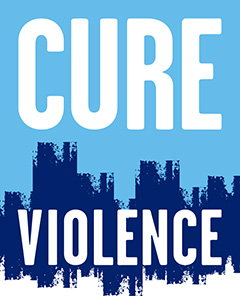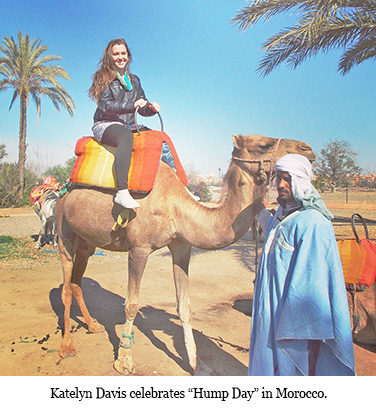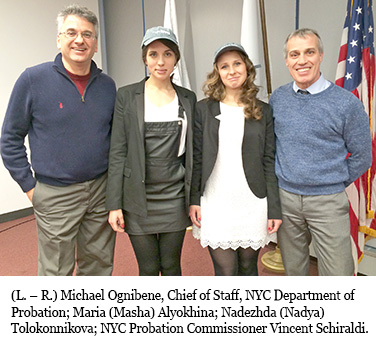Center Receives $3-Million Grant to Evaluate Gun-Violence Reduction Model
 The Research and Evaluation (R&E) Center at John Jay College of Criminal Justice has received a grant of nearly $3 million from the Robert Wood Johnson Foundation to evaluate the efficacy and outcomes of the “Cure Violence” model of gun-violence reduction.
The Research and Evaluation (R&E) Center at John Jay College of Criminal Justice has received a grant of nearly $3 million from the Robert Wood Johnson Foundation to evaluate the efficacy and outcomes of the “Cure Violence” model of gun-violence reduction.
As part of the two-year project titled “Evaluating the Cure Violence model for gun-violence prevention,” the research team will study the key components of the model, the procedures used to implement it, and its effectiveness in reducing pro-violence social norms in high-risk communities. The Robert Wood Johnson Foundation selected the Center for Court Innovation (CCI) to implement the Cure Violence approach in two New York City neighborhoods, and the R&E Center will collect data in those communities and two comparison communities.
President Jeremy Travis touted the award, saying: “For those of us in the crime policy world, the fact that John Jay has been selected, with partners, to evaluate the Cure Violence initiative is a great vote of confidence in our ability to deliver a credible and rigorous evaluation of this high profile strategy.”
Since Jeffrey Butts became Director of the R&E Center in 2010, the center’s research team has raised $8 million in funding for various projects
“The center is excited to work with CCI to implement high-quality Cure Violence programs,” said Butts. “John Jay will track implementation and measure effects in community in both the implementation site and in comparison communities all within New York City. This is a real vote of confidence in New York City and how the city is implementing a public health approach to violence prevention which has been supported by the City Council, public health, and the State.”
The Cure Violence model is a public health approach to ending gun violence that uses what are termed credible messengers, such as formerly incarcerated individuals, to intervene in gun-related violence, usually among youths ages 15 to 25. The Cure Violence model asserts that its public health approach can change high-risk individuals’ violent behavior through specifically-targeted mentoring from “violence interrupters.” Using such an approach, gun violence reduction can be achieved without individuals having to be embroiled in the legal system.
_______________________________________________________________________________
For John Jay Student-Athlete,Study Abroad Is a Life-Changing Experience
While most John Jay students were relaxing and recharging their batteries during the end-of-semester break in January, s ophomore Katelyn Davis was one of 15 ambitious souls who spent an intensive three weeks in Morocco as part of a winter-session study abroad adventure.
ophomore Katelyn Davis was one of 15 ambitious souls who spent an intensive three weeks in Morocco as part of a winter-session study abroad adventure.
For Davis, the trip from her upstate New York hometown of Hurley to Rabat, the Moroccan capital, could be measured in more than miles. It also represented a dramatic cultural adjustment, as Davis admitted, “This will be my first time on a plane and out of the country.”
Taught by Professor Chitra Raghavan of the Department of Psychology, the course on “Psychology of Gender” was designed to be academically rigorous, with lectures and discussions, field trips, presentations and language immersion. Participants also engaged in a community service project at a Moroccan school.
“I enjoyed being challenged academically, while having to constantly reflect on my personal growth in weekly journals and expanding my understanding of Morocco through assigned scholarly articles,” Davis said of Professor Raghavan’s leadership of the class.
By most yardsticks, Davis is not your average student. She is a stellar student-athlete who sports a 3.785 GPA as a Criminal Justice major (with double minors in Psych and Music), and serves as captain of the John Jay women’s soccer team. She was selected as a second-team all-star by the CUNY Athletic Conference for the 2013 season. Her experience with living independently in New York City, coupled with her polished teamwork skills, served her well during the whole study-abroad experience.
“Although preparedness is very important to me, I chose not to do any ‘boning up’ before leaving for Morocco,” she recalled. “I wanted to save the culture shock for arrival. I realized that I wouldn’t be traveling alone at any point during the trip, and I knew that I could trust in my decision-making and teamwork skills to make the trip successful.”
Davis and her fellow students were in fact well prepared for their overseas adventure. She singled out the help of Anderson Rosa and Maureen Coyle of John Jay’s Office of International Studies and Programs, as well as the encouragement of Danielle Rosario, the student-athlete academic advisor in the Department of Athletics. “The overall process of preparing for the study abroad trip was great,” Davis said.
In addition to the formal academic components of the course, Davis said, students were encouraged to break away independently of the group setting and venture around the country. “While visiting Marrakesh, my roommate and I found an excursion agency that allowed us to tent out in the Sahara desert for one night and sleep in Berber tents. It took about eight hours to drive up the Atlas Mountains on a winding road, but as soon as we got to the top, the sun was setting and we saddled up for a two-hour camel ride into the Sahara. We enjoyed a delicious couscous meal and listened to Moroccan drumming while learning to sing along to a few Arabic songs.” Capping the experience was the most spectacular starscape either of the young women had ever witnessed — “the best television you can watch,” their tour guide said of the night sky.
As luck would have it, Davis was in Morocco as history was being made. She noted in a January 10 posting on Facebook: “Article 475 of the Moroccan Penal Code has been appealed today!!! Can't believe that we are around to witness this. Go Morocco!” The law in question, which would be repealed on January 22, shortly after the John Jay students’ return to America, was a holdover from Morocco’s colonial era. It allowed a rapist to avoid prosecution by marrying his underage victim.
Repeal of the law is seen by human rights activists as part of a broader effort to promote gender equality, outlaw child marriage and protect women from violence.
Davis, who hopes to go on to earn a master’s degree and ultimately join the FBI, says she has been bitten by the “travel bug” as a result of her study-abroad experience. “I would take an experience like the Morocco study abroad over an ordinary vacation any day,” she said. Equally important, she wants to encourage fellow students to look into studying abroad. “It really is an experience that will change your life and your perceptions of the world we live in.”
[To learn more about John Jay’s study-abroad programs, contact the Office of International Studies and Programs at 212.484.1339.]
_______________________________________________________________________________
Florida Investigative Reporters Sweep
Criminal Justice Journalism Prizes
Prison Reform Advocate Piper Kerman Wins ‘Justice Trailblazer’ Award

Three intrepid investigative journalists from South Florida newspapers won the 2013-2014 John Jay College/Harry Frank Guggenheim 2013-2014 Excellence in Criminal Justice Reporting Awards, which were presented February 10 at an awards dinner held in conjunction with the 9th annual John Jay/Harry Frank Guggenheim Symposium on Crime in America.
The prizes, which honor print and online justice reporting that has had a noteworthy impact on public policy or debate during the year, were awarded to David McSwane of the Sarasota Herald-Tribune and Megan O’Matz and John Maines of the South Florida Sun-Sentinel.
At the awards dinner, the CMCJ also honored Piper Kerman, author of Orange is the New Black, the memoir on which the hit Netflix series is based, with its 2014 Justice Trailblazer award, in recognition of her contribution to focusing the public’s attention on life inside the U.S. penal system.
McSwane’s article “The Stolen Ones,” a 44-page special report on child sex trafficking rings in Florida, won the award for Best Single Story. O’Matz and Maines were honored in the Best Series category for “Cops, Cocaine, Cash,” a two-part examination of how narcotics police paid informants to draw drug dealers to the city of Sunrise, FL, and then used millions of dollars in proceeds from drug busts to pay police overtime and buy guns, cars and other items for the department.
“We are proud to salute the reporters from the Sarasota Herald-Tribune and the South Florida Sun-Sentinel for their impressive work and their contributions to the national dialogue on crime,” said President Jeremy Travis. “They exemplify the crucial role the media play — and must continue to play — in examining our criminal justice system at every level.”
CMCJ Director Stephen Handelman added, “The high quality of our entries made this year’s contest for the best U.S. crime journalism one of our most competitive to date.”
The evening’s master of ceremonies was Errol Louis, host of the popular NY1 show “Inside City Hall,” who reminded the audience that despite the impressive work being done by the award winners and others, so much remains to be done in the realm of criminal justice reporting. “You can’t talk about freedom in a democracy without talking about those whose freedom has been taken away,” Louis said.
Kerman’s memoir was based in part on her experience serving 14-month federal prison sentence beginning in 2004. Since then she has become a forceful advocate for justice reform. Prefacing her remarks by noting that “you can’t make this stuff up,” Kerman told the audience: “The stories of real people in the criminal justice system debunk conventional reform. People need to hear these stories.”
“The criminal justice system fails so many people in so many ways,” Kerman said. The winning journalism entries will be posted on the John Jay Center on Media, Crime and Justice Web site, http://www.jjay.cuny.edu/cmcj/.
_______________________________________________________________________________
From the Cornhusker State to the Big Apple:
U. of Nebraska President Tapped as New CUNY Chancellor
 James B. Milliken, the President of the University of Nebraska system since 2004 and a nationally prominent leader in public higher education, has been appointed as the City University of New York’s seventh Chancellor. The CUNY Board of Trustees, acting on the recommendation of a 16-member search committee, approved Milliken’s appointment on January 16.
James B. Milliken, the President of the University of Nebraska system since 2004 and a nationally prominent leader in public higher education, has been appointed as the City University of New York’s seventh Chancellor. The CUNY Board of Trustees, acting on the recommendation of a 16-member search committee, approved Milliken’s appointment on January 16.
Both the board’s and the search committee’s endorsements were unanimous.
Milliken, who holds a law degree from New York University School of Law, has worked with the Legal Aid Society’s Civil Division as well as the blue-chip law firm of Cadwalader, Wickersham & Taft. He has served in numerous leadership roles on the state, national and international levels, including recently representing the United States in the U.S.-India Strategic Dialogues conference in New Delhi with Secretary of State John Kerry. In 2009, the Obama Administration nominated him as a delegate and invited expert to the UNESCO World Conference on Higher Education in Paris. He has led the development of research and education programs in China, India and Brazil, among other countries.
Prior to assuming the presidency of the University of Nebraska system, he was Senior Vice President for University Affairs at the 16-campus University of North Carolina system.
Benno Schmidt, Chairman of the CUNY Board of Trustees, hailed Milliken as “a highly regarded national leader in higher education [who] brings to CUNY an impressive record of extensive academic and administrative experience and a demonstrated record of success in working with students, faculty, alumni and community leaders to offer quality, affordable higher education.”
Milliken said he was “honored and excited by this appointment to lead America’s premier urban public university,” and cited CUNY’s “world-class faculty, talented students, an outstanding reputation, rising enrollments, increased academic standards and the most diverse student body in the nation” as key ingredients of the university’s “unlimited potential.”
Under Milliken’s leadership, the University of Nebraska made record investments in financial aid, including Collegebound Nebraska, a program that assures that qualifying Nebraska students can attend NU tuition-free. He also oversaw record levels of fundraising for the university, both in governmental support and private donations.
Milliken will take office no later than June 1, 2014. Dr. William P. Kelly is currently serving as CUNY’s interim Chancellor, following the retirement last year of Matthew Goldstein.
_______________________________________________________________________________
Activist Performers “Pussy Riot” Bring Human Rights Campaign to John Jay
 Freed barely a month ago after spending two years in the Russian penal system, two of that country’s foremost political dissidents – Nadezhda (Nadya) Tolokonnikova and Maria (Masha) Alyokhina of the punk ensemble Pussy Riot – brought their campaign for human rights and prison reform to John Jay College of Criminal Justice on February 6.
Freed barely a month ago after spending two years in the Russian penal system, two of that country’s foremost political dissidents – Nadezhda (Nadya) Tolokonnikova and Maria (Masha) Alyokhina of the punk ensemble Pussy Riot – brought their campaign for human rights and prison reform to John Jay College of Criminal Justice on February 6.
The campaign known as “Zona Prava” (Justice Zone) had made its first stop at the Bring Human Rights Home concert sponsored by Amnesty International and held at Brooklyn’s Barclays Center. The exclusive closed-door session at John Jay was organized by Professor Lorraine Moller of the Department of Communication and Theatre Arts and Kevin Barnes-Ceeney, Director of Research for the Prisoner Reentry Institute, and focused on the efficacy of prison-based arts programs.
The meeting was arranged with the help of The Voice Project, a non-governmental organization that seeks to use the power of music to promote social change.
Barnes-Ceeney discussed the use of art and design to change institutional culture, providing examples drawn from his ongoing study with Professor Jeff Mellow of the Department of Probation’s work to improve the environment in probation waiting rooms. He also presented examples of prison-based art programs, drawn from his audit of 177 art programs currently operating in U.S. correctional facilities. These commonly include creative writing classes, art classes, poetry writing and performance, drama productions, expressive performance workshops and exhibitions of inmate artwork.
He outlined the potential positive benefits of prison-based art programs, along with the potential for such programs to reduce recidivism when integrated within a broader educational curriculum.
New York City Probation Commissioner Vincent Schiraldi and his Chief of Staff, Michael Ognibene, who have been instrumental in creating or expanding arts programs within the New York City probation system, discussed the challenges of changing staff culture, and identified strategies for utilizing leverage points to embed rehabilitative programming in correctional contexts.
Moller drew on her years of experience teaching theater in prisons in New York and Thailand to discuss the healing powers of art. Language barriers and the need for translation notwithstanding, Nadya and Masha were quick to grasp Moller’s description of how theater heals prison culture.
Nadya and Masha, who were imprisoned for their vocal opposition to the policies of Russian President Vladimir Putin, are still evolving their prison reform and human rights agenda, and view the implementation of art programs as a long-term goal. They informed the session’s participants that there are comparatively few relevant correctional programs in Russia, which in turn means there are many more bases to cover.
The New York and John Jay participants, for their part, cautioned the Russian activists that the road ahead will be difficult, requiring strength, patience and diplomacy, but they said they would provide Zona Prava with scholarly support and partnership recommendations.
Faculty/Staff Notes
Presenting. . .
Ann A. Huse (English) gave a paper titled "Satiric Justice: The Rose Alley Affair Revisited," at the Northeast American Society of Eighteenth-Century Studies meeting at Yale University on October 3-6, 2013. The incident referred to in the title was an unsolved assault on the then-Poet Laureate of Great Britain, John Dryden.
The Printed Page
Samantha Majic (Political Science) has been appointed to the editorial board of Perspectives on Politics, a peer-reviewed journal published by the American Political Science Association. Majic’s latest book, the co-edited volume Negotiating Sex Work: Unintended Consequences of Policy and Activism,is scheduled to be published by the University of Minnesota Press this spring. On December 23, 2013, Majic was a guest contributor to “The Monkey Cage,” a politics blog on the Washington Post Web site, where she posted the commentary “What Prostitutes Can Teach the Canadian Government.”
Susan Opotow (Sociology) wrapped up a three-year term as editor of Peace and Conflict: Journal of Peace Psychology with a special issue (November 2013) on “Museums as Sites for Historical Understanding, Peace and Social Justice: Views from Canada.” The journal is an official publication of the American Psychological Association. The special issue includes the article “Reflections on Peace and Conflict: An Outsider Inside Peace Psychology” by Timothy Luke, a John Jay alumnus who is now a doctoral student in the Psychology and Law program at the CUNY Graduate Center.
Betsy Hegeman (Anthropology) recently published a blog titled "Will you be safer if you buy a gun?" on the Web site psychologytoday.com. Hegeman serves on the Gun Violence Prevention-Social Responsibility Committee in the Social Responsibility Section of the American Psychological Association’s Psychoanalysis Division. She and Katie Gentile (Counseling) also participated in two recent panels: one on "Psychology and the Other" at Lesley University in Cambridge, MA, on October 6, and another at the annual conference of the Association for the Psychoanalysis of Culture and Society, on November 1-2 in New Brunswick, NJ.
Daniel Feldman (Public Management) is co-author of the new book The Art of the Watchdog: Fighting Fraud, Waste, Abuse, and Corruption in Government. Feldman and David R. Eichenthal provide expert advice, tools and techniques for identifying government waste and inefficiency and how people can act to enhance government strength and integrity. Feldman was a member of the New York State Assembly from 1981–1998.
John Gutierrez (Latin American and Latina/o Studies) published an op-ed in El Diario/La Prensa on January 8 on the election of Melissa Mark-Viverito as the first Latina Speaker of the New York City Council.
Cara Tabachnick (Center on Media, Crime and Justice) authored an article, “We teach U.S. kids to dial 911 for help, but too often that doesn't work,” which was published in The Guardian on January 14. The article discusses the tragic consequences that can occur when emergency communications fail, citing a case in which a Texas mother with three young children was murdered in a motel room, and when her 9-year-old daughter tried to call for help, the call was not completed because she had to dial the prefix "9."
Grantsmanship
Claudia Calirman (Art and Music) has received a 2013 Creative Capital/Warhol Foundation Arts Writers Grant, which she will use to write her second book, A Study from the Margins: Female Practices in Brazil and Chile. The book will focus on female artists from Brazil and Chile from the 1970s and 1980s who appropriated the term “marginality” as a means of opting out of mainstream ideology and politics.
